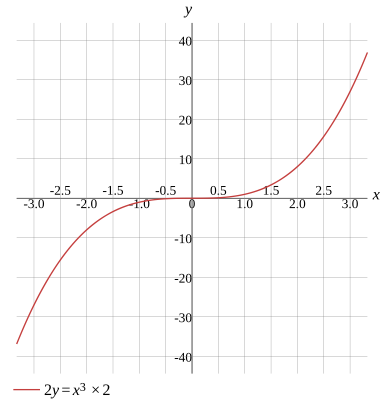Question
Function
Find the x-intercept/zero
Find the y-intercept
x=0
Evaluate
2y=x3×2
To find the x-intercept,set y=0
2×0=x3×2
Any expression multiplied by 0 equals 0
0=x3×2
Use the commutative property to reorder the terms
0=2x3
Swap the sides of the equation
2x3=0
Rewrite the expression
x3=0
Solution
x=0
Show Solution

Solve the equation
Solve for x
Solve for y
x=3y
Evaluate
2y=x3×2
Use the commutative property to reorder the terms
2y=2x3
Swap the sides of the equation
2x3=2y
Divide both sides
22x3=22y
Divide the numbers
x3=22y
Divide the numbers
More Steps


Evaluate
22y
Reduce the numbers
1y
Calculate
y
x3=y
Take the 3-th root on both sides of the equation
3x3=3y
Solution
x=3y
Show Solution

Testing for symmetry
Testing for symmetry about the origin
Testing for symmetry about the x-axis
Testing for symmetry about the y-axis
Symmetry with respect to the origin
Evaluate
2y=x32
Simplify the expression
2y=2x3
To test if the graph of 2y=2x3 is symmetry with respect to the origin,substitute -x for x and -y for y
2(−y)=2(−x)3
Evaluate
−2y=2(−x)3
Evaluate
More Steps


Evaluate
2(−x)3
Rewrite the expression
2(−x3)
Multiply the numbers
−2x3
−2y=−2x3
Solution
Symmetry with respect to the origin
Show Solution

Rewrite the equation
r=0r=cos3(θ)sin(θ)r=−cos3(θ)sin(θ)
Evaluate
2y=x3×2
Use the commutative property to reorder the terms
2y=2x3
Move the expression to the left side
2y−2x3=0
To convert the equation to polar coordinates,substitute x for rcos(θ) and y for rsin(θ)
2sin(θ)×r−2(cos(θ)×r)3=0
Factor the expression
−2cos3(θ)×r3+2sin(θ)×r=0
Factor the expression
r(−2cos3(θ)×r2+2sin(θ))=0
When the product of factors equals 0,at least one factor is 0
r=0−2cos3(θ)×r2+2sin(θ)=0
Solution
More Steps


Factor the expression
−2cos3(θ)×r2+2sin(θ)=0
Subtract the terms
−2cos3(θ)×r2+2sin(θ)−2sin(θ)=0−2sin(θ)
Evaluate
−2cos3(θ)×r2=−2sin(θ)
Divide the terms
r2=cos3(θ)sin(θ)
Evaluate the power
r=±cos3(θ)sin(θ)
Separate into possible cases
r=cos3(θ)sin(θ)r=−cos3(θ)sin(θ)
r=0r=cos3(θ)sin(θ)r=−cos3(θ)sin(θ)
Show Solution

Find the first derivative
Find the derivative with respect to x
Find the derivative with respect to y
dxdy=3x2
Calculate
2y=x32
Simplify the expression
2y=2x3
Take the derivative of both sides
dxd(2y)=dxd(2x3)
Calculate the derivative
More Steps


Evaluate
dxd(2y)
Use differentiation rules
dyd(2y)×dxdy
Evaluate the derivative
More Steps


Evaluate
dyd(2y)
Use differentiation rule dxd(cf(x))=c×dxd(f(x))
2×dyd(y)
Use dxdxn=nxn−1 to find derivative
2×1
Any expression multiplied by 1 remains the same
2
2dxdy
2dxdy=dxd(2x3)
Calculate the derivative
More Steps


Evaluate
dxd(2x3)
Use differentiation rule dxd(cf(x))=c×dxd(f(x))
2×dxd(x3)
Use dxdxn=nxn−1 to find derivative
2×3x2
Multiply the terms
6x2
2dxdy=6x2
Divide both sides
22dxdy=26x2
Divide the numbers
dxdy=26x2
Solution
More Steps


Evaluate
26x2
Reduce the numbers
13x2
Calculate
3x2
dxdy=3x2
Show Solution

Find the second derivative
Find the second derivative with respect to x
Find the second derivative with respect to y
dx2d2y=6x
Calculate
2y=x32
Simplify the expression
2y=2x3
Take the derivative of both sides
dxd(2y)=dxd(2x3)
Calculate the derivative
More Steps


Evaluate
dxd(2y)
Use differentiation rules
dyd(2y)×dxdy
Evaluate the derivative
More Steps


Evaluate
dyd(2y)
Use differentiation rule dxd(cf(x))=c×dxd(f(x))
2×dyd(y)
Use dxdxn=nxn−1 to find derivative
2×1
Any expression multiplied by 1 remains the same
2
2dxdy
2dxdy=dxd(2x3)
Calculate the derivative
More Steps


Evaluate
dxd(2x3)
Use differentiation rule dxd(cf(x))=c×dxd(f(x))
2×dxd(x3)
Use dxdxn=nxn−1 to find derivative
2×3x2
Multiply the terms
6x2
2dxdy=6x2
Divide both sides
22dxdy=26x2
Divide the numbers
dxdy=26x2
Divide the numbers
More Steps


Evaluate
26x2
Reduce the numbers
13x2
Calculate
3x2
dxdy=3x2
Take the derivative of both sides
dxd(dxdy)=dxd(3x2)
Calculate the derivative
dx2d2y=dxd(3x2)
Simplify
dx2d2y=3×dxd(x2)
Rewrite the expression
dx2d2y=3×2x
Solution
dx2d2y=6x
Show Solution

Graph
